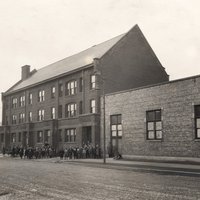
Exhibition curated by Susan Sessions Rugh, Special Collections Research Center Exhibition Researcher.
The growth of settlement houses in Chicago and other cities in the late nineteenth century sprang from a desire to apply religious ideals to urban neighborhood reform. A generation of settlement residents set out to change the social environment, not through acts of charity, but by living among the people they were trying to help. Inspired by Toynbee Hall in London, the settlement movement in the United States grew from six settlements in 1891 to 400 at its peak in 1910. Young college-educated, usually unmarried, and often possessed of financial means, settlement workers were keenly concerned about the poverty, over-crowding, and poor working conditions resulting from the influx of immigrants into the nation's cities. Conditions in Chicago were particularly acute. The vanguard of settlement houses in Chicago was Hull-House, founded by Jane Addams in 1889. Two other settlement houses with ties to the University of Chicago, Chicago Commons and the University of Chicago Settlement, are also featured int his exhibit, which commemorates Jane Addams and the founding of Hull-House. Materials for this exhibit were drawn from the Department of Special Collections. Photographs are from the Archival Photographic Files.